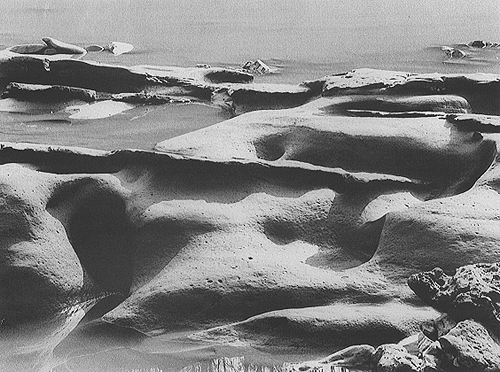
Fine-grained structureless beds
Plate 20

Fine-grained structureless beds
Plate 20
Sediment of fine texture, whatever their composition, can form structureless beds, too. This example comes from the same Pliocene formation already shown in previous plates. It is exposed along a river bed, where the alluvial cover has been removed by recent erosion promoted by anthropic causes. The action of running water keep the rock surface "fresh and clean," whereas in normal outcrops it is usually covered by a weathered layer of variable thickness.
The thicker and softer beds are made of silt material (now compacted into siltstone). Various admixtures of sand and/or clay can be combined with silt. Siltstones and claystones are both comprised within the more general term mudstone. Thinner beds of sandstone are interspersed with the siltstone. Their top is wavy and the internal part laminated (back lighting masks the laminae). The hummocks were produced by waves (see more on this structure in plates 47-49).
The question, here, is to explain why unstructured and structured deposits alternate in time in the same place. Let us start with the sands, which do have structures; these structures indicate wave action, i.e., a relatively shallow water, where waves could exert traction and friction on the bottom. The supply of sand was modest and did not persist for a long time, thus giving thin beds. Assume now that the bottom deepens under the reach of waves, the so-called wave base. Waves are no more able to bring and mold sand. Finer material can settle on the quieter bottom. If it is supplied at a slow rate, it will takea relatively long time to build a thick bed; if, on other hand, the sedimentation rate (quantity of sediment arriving on the bottom per unit time) is high, a thick bed can take a short time to accumulate. Whatever the rate, these beds could possibly reflect fluctuations of water depth around the wave base level. There is another possibility: that structures were present also in siltstone beds but were later effaced, for instance by organisms that thoroughly mixed and homogenized the sediment. From time to time, the sea bottom became inhospitable for these organisms, the waves sorted the sand grains out of the silty sediment, and the laminae could be preserved. Then, animal life repopulated the depositional interface and bioturbation started again. The two explanations are not necessarily incompatible, and might be combined.
In any case, what is remarkable in this reasoning is the application of the principle of negative evidence, which is of the utmost importance in geologic work. The absence of a character (structures in general, or specific types) does not mean absence of information. On the contrary, it conveys some message, first by excluding certain phenomena (those which produce the positive evidence) and, second, by obliging geologists to ask why a given character (which we would expect) is absent. Furthermore, there could be some hints at the cause of the absence; they could take the form of relics, or "ghosts" of the original structures or of overprinted features, such as traces of organic activity.
Pliocene Intra-apenninic Basin, Reno Valley, northern Apennines.